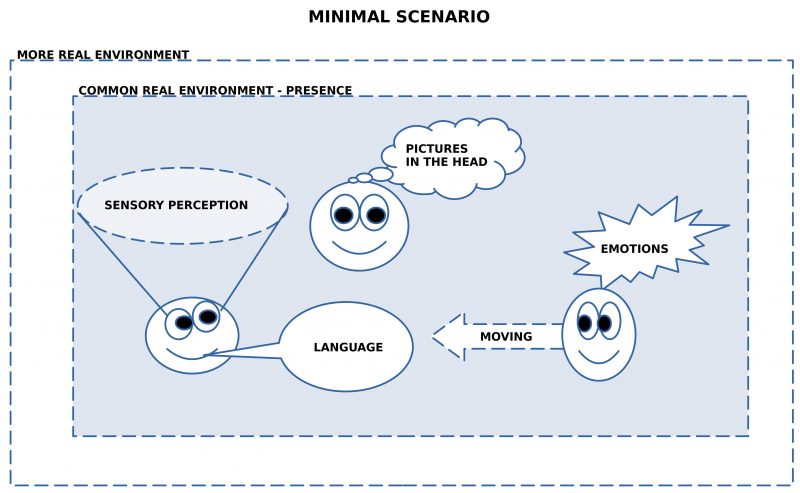eJournal: uffmm.org
ISSN 2567-6458, 6.January 2023 – 6.January 2023, 09:48 a.m.
Email: info@uffmm.org
Author: Gerd Doeben-Henisch
Email: gerd@doeben-henisch.de
Parts of this text have been translated with www.DeepL.com/Translator (free version), afterwards only minimally edited.
CONTEXT
This post is part of the book project ‘oksimo.R Editor and Simulator for Theories’.
What to assume for a minimal scenario?

If you want to play a ‘game’ together, then you usually need a ‘starting position’ with which you begin. In addition different ‘materials’, which are in the starting position or which one can ‘bring in’ or ‘take out’. You need ‘players’ who share this situation. One needs a ‘language’ to be able to communicate. One needs ‘rules of the game’ (= pictures in the head), which are to be ‘considered’ while playing. One needs to be able to perform different ‘game actions’ (= movements), and one experiences in the game that every fellow player shows very different emotions that influence him when acting.
In real everyday life this is not different. One can perhaps say that ‘games’ represent idealized everyday situations’; in principle, everything is there, only simpler, rather complete.
In real everyday life, in principle, almost everything can change at any time. Sometimes in the short term, sometimes in the long term. Actors can come and go, get sick or old. The weather goes crazy; there are seasons. Houses, roads and bridges are built or torn down. Plants grow and disappear. People rejoice, laugh, get sad, cry, scream, go crazy.
Without the ‘sensual perception’ we human actors would know nothing of the ‘world out there’, of the ‘body world’ in which we find our own body. People who are blind, or deaf, who have no tactile sensations, who cannot smell … for them the world is dim, distant, always little tangible.
Whatever we perceive, all kinds of ’emotions’ constantly exist within us; a vast spectrum of different ‘states of excitement’ that ‘fill’ us, that we perceive as rather ‘pleasant’ or ‘unpleasant’; they come and go without our being able to control them completely. And yet they seem to follow fixed laws …
The human body with its different body parts, but also its surface, allows changes in the form of movements. These partly have an effect on the own body, on the own sensory perception, but partly these movements also cause changes in the environment, leave traces on the body of another human actor. Over the years, children complete a huge movement program, which does not stop in adulthood, which does not have to stop.
Children learn to ‘speak’ very early, just like that, alone, but then increasingly also in community. This speaking differentiates itself more and more in the course of the years in vocabulary, expression, emphasis, situation reference …
One and the same situation different people often describe it very differently! One sees the fruit, the other the flowers, still another the car, the wall, other people, insects …. This indicates that we do not keep the surrounding world 1-to-1 in us, but only parts of it, depending on current ‘interests’. The ‘world inside us’ is therefore usually only a ‘fragment’ of the real world around us, a world that has been ‘simplified’, which we can partially ‘remember’ again mostly, not always. And we also know that ‘memories’ can change ‘in us’. The ‘remembered world’ can thus have an ‘existence of its own’ at some point: The ‘pictures in our head’ are real for us, they represent ‘the world’ for us, and we don’t necessarily realize that these ‘pictures in our head’ don’t ‘represent’ the real world….
So it is possible – and perhaps even the ‘normal case’ – that people carry around ‘images in their heads’ that are more or less ‘false’; that are additionally linked to different ’emotions’ that may be ‘misleading’; that we use ‘ways of talking’ that make the whole thing to appear to be ‘true’, which can lead to ‘actions’ that are guided by these unrealistic presuppositions.”[1]
These considerations draw the picture of a – strongly simplified – minimal scenario, however only the ‘surface’. As one can already see in a hint, behind the ‘surface phenomena’ there is an ‘inner world’ in the human actors; of course also in the – so far not mentioned – other ‘biological actors’, which populate this planet with us. Yes, even in the ‘a-biological’ material of our everyday life: stones, metals, plastics, dead wood, … there is an ‘inner life’.
A direct continuation can be found HERE.
COMMENTS
[1] I run out into the waterless mudflats and am suddenly surprised by the receding water. I don’t make it to the beach. Or: I urgently have to go to a meeting and rush to my bicycle, but it’s not there because a friend has just ‘borrowed’ it. Or: We eat in a restaurant in a good mood, and the night brings nausea and vomiting to many; the food was spoiled. Or: I dream of a lot of money, get involved with a financial advisor, give him money, and the whole project turns out to be a ‘junk project’. Or: I cultivate my field, use a certain seed. The plants start growing, and then there are numerous storms that leave little of the plants usable. Or: Someone else tells me a story about evil people who want to rule the world (he says he read it), and because of that he now has to fight his own government. …. Everyone knows long lists of such experiences.
